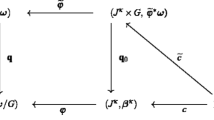Abstract
From the symplectic representation of an autonomous nonlinear dynamical system with holonomic constraints, i.e., those that can be represented through a symplectic form derived from a Hamiltonian, we present a new proof on the realization of the symplectic feedback action, which has several theoretical advantages in demonstrating the uniqueness and existence of this type of solution. Also, we propose a technique based on the interpretation, construction and characterization of the pull-back differential on the symplectic manifold as a member of a one-parameter Lie group. This allows one to synthesize the control law that governs a certain system to achieve a desired behavior; and the method developed from this is applied to a classical system such as the inverted pendulum.
Similar content being viewed by others
References
A. Isidori. Nonlinear Control Systems. 3rd ed. Berlin: Springer-Verlag, 1995.
A. Venkatraman, A. J. van der Schaft. Full-order observer design for a class of port-hamiltonian systems. Automatica, 2010, 46(3): 555–561.
A. Boulkroune, M. Tadjine, M. M’Saad, et al. How to design a fuzzy adaptive controller based on observers for uncertain affine nonlinear systems. Fuzzy Sets and Systems, 2008, 159(8): 926–948.
Z. Xi, J. Lam. Stabilization of generalized Hamiltonian systems with internally generated energy and applications to power systems. Nonlinear Analysis-Real World Applications, 2008, 9(3): 1202–1223.
V. I. Arnold. Mathematical Methods of Classical Mechanics. 2nd ed. New York: Springer-Verlag, 1989.
R. Abraham, J. Jerrold, E. Marsden. Foundations of Mechanics: A Mathematical Exposition of Classical Mechanics with An Introduction to the Qualitative Theory of Dynamical Systems and Applications to the Three Body Problem. 2nd ed. Boston: Addison-Wesley, 1987.
H. K. Khalil. Nonlinear Systems. 3rd ed. London: Prentice Hall, 2002.
R. W. Broquett. Control theory and analytical mechanics, Geometric Control Theory. Lie Groups: History, Frontiers and Applications. New York: Mathematical Sciences, 1977: 1–46.
A. J. V. der Shaft, B. M. Maschke. On the hamiltonian formulation of nonholonomic mechanical systems. Mathematical Physics, 1994, 34(2): 225–233.
T. R. Jerrold, E. Marsden, R. Abraham. Manifolds, Tensor Analysis, and Applications. 3rd ed. New York: Springer-Verlag, 2002.
D. Eberard, B. M. Maschke. An extension of Hamiltonian systems to the thermodynamic phase space: towards a geometry of nonreversible processes. Mathematical Physics, 2007, 60(2): 175–198.
C. Valentin, M. Magos, B. Maschke. A port-Hamiltonian formulation of physical switching systems with varying constraints, Automatica, 2007, 43(7): 1125–1133.
A. J. van der Shaft. Port-controlled hamiltonian systems: towards a theory for control and design of nonlinear physical systems. Journal of the Society of Instrument and Control Engineers of Japan, 2000, 39(2): 91–98.
J. Cervera, A. J. van der Schaft, A. Banos. Interconnection of port-Hamiltonian systems and composition of Dirac structures. Automatica, 2007, 43(2): 212–225.
Y. Wang, S. S. Ge. Augmented Hamiltonian formulation and energy-based control design of uncertain mechanical systems. IEEE Transactions on Control Systems Technology, 2008, 16(2): 202–213.
Y. Wang, G. Feng, D. Cheng. Simultaneous stabilization of a set of nonlinear port-controlled Hamiltonian systems. Automatica, 2007, 43(3): 403–415.
L. Li, F. Yu, X. Liu. Feedback control of fractional nonlinear differential algebraic systems with Hamiltonian function method. Applied mathematics and computation, 2008, 197(2): 904–913.
H. Sira-Ramirez. A general canonical form for sliding mode control of nonlinear systems. Variable Structure Systems, Sliding Mode Aand Nonlinear Control. K. D. Young, U. Ozguner, Ed. in Lecture Notes in Control and Information Sciences. London: Springer-Verlag, 1999, 247: 123–142.
R. Ortega, A. J. van der Schaft, F. Castanos, et al. Control by interconnection and standard passivity-based control of port-Hamiltonian systems. IEEE Transactions On Automatic Control, 2008, 53(11): 2527–2542.
M. A. Belabbas. Networks of hamiltonian systems and feedback. Systems & Control Letters, 2009, 58(3): 217–224.
C. J. Isham. Modern Differential Geometry for Phisicists. 2nd ed. Singapore: World Scientific, 2001.
B. L. van der Waerden. Group Theory and Quantum Mechanics. 2nd ed. Berlin: Springer-Verlag, 1974.
Author information
Authors and Affiliations
Corresponding author
Additional information
J. Lorca ESPIRO was born in Temuco, Chile, in 1984. He received his Electronics Engineering title in 2008, he also holds a B.S. degree in Physics and a M.S. degree in Engineering Sciences from Universidad de La Frontera. He is currently active in areas of theoretical and mathematical physics, such as quantum field theory and gravitation and cosmology, as well as in classical mechanics and symplectic geometry.
C. Muñoz POBLETE was born in Collipulli, Chile, in 1966. He graduated in Electronic Engineering in 1990 at the Department of Electrical Engineering (DIE) of the Universidad de La Frontera (Chile), and received his Ph.D. degree in Engineering Sciences at the Pontificia Universidad Catlica (Chile) in 2001. He is currently an associate professor of Automatic Control at DIE. His research interest include nonlinear and predictive control, and wireless sensor networks.
Rights and permissions
About this article
Cite this article
Espiro, J.L., Poblete, C.M. Symplectic feedback using Hamiltonian Lie algebra and its applications to an inverted pendulum. J. Control Theory Appl. 11, 275–281 (2013). https://doi.org/10.1007/s11768-013-1073-7
Received:
Revised:
Published:
Issue Date:
DOI: https://doi.org/10.1007/s11768-013-1073-7




